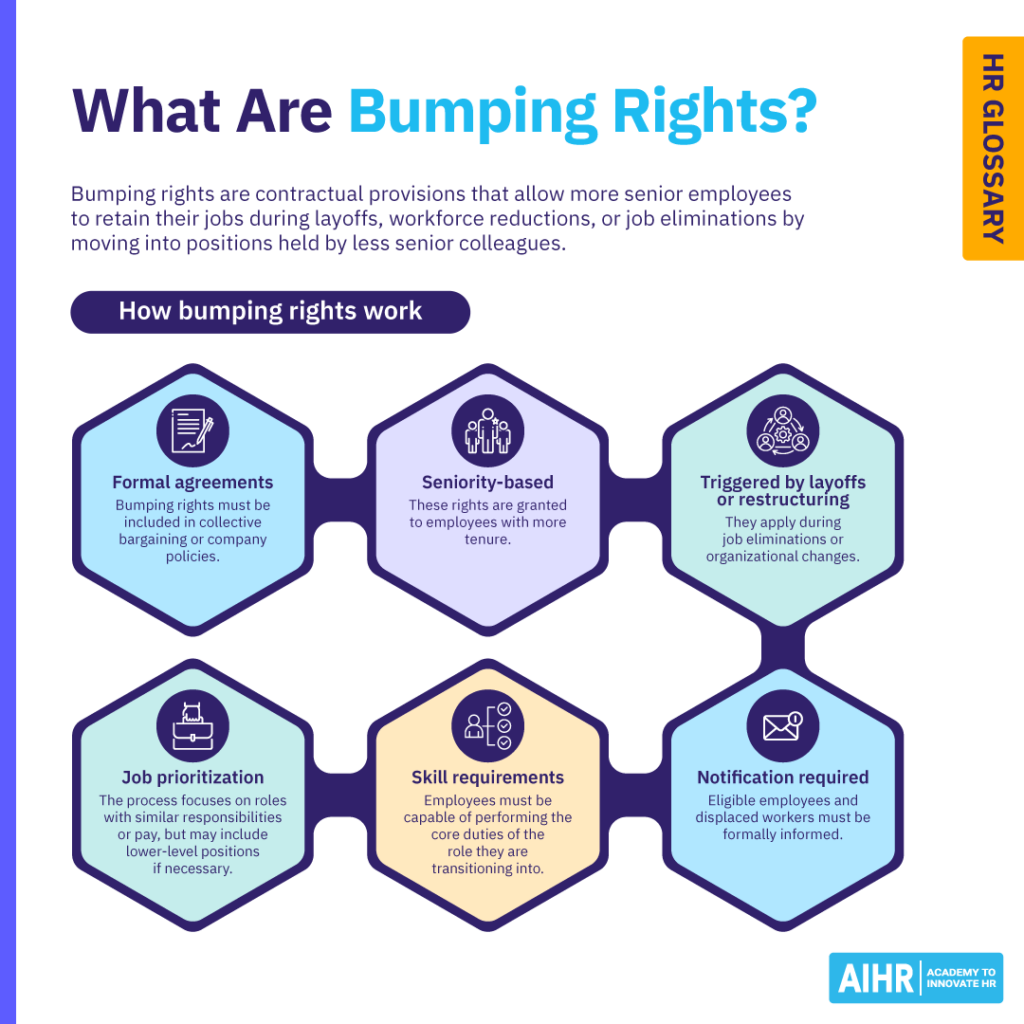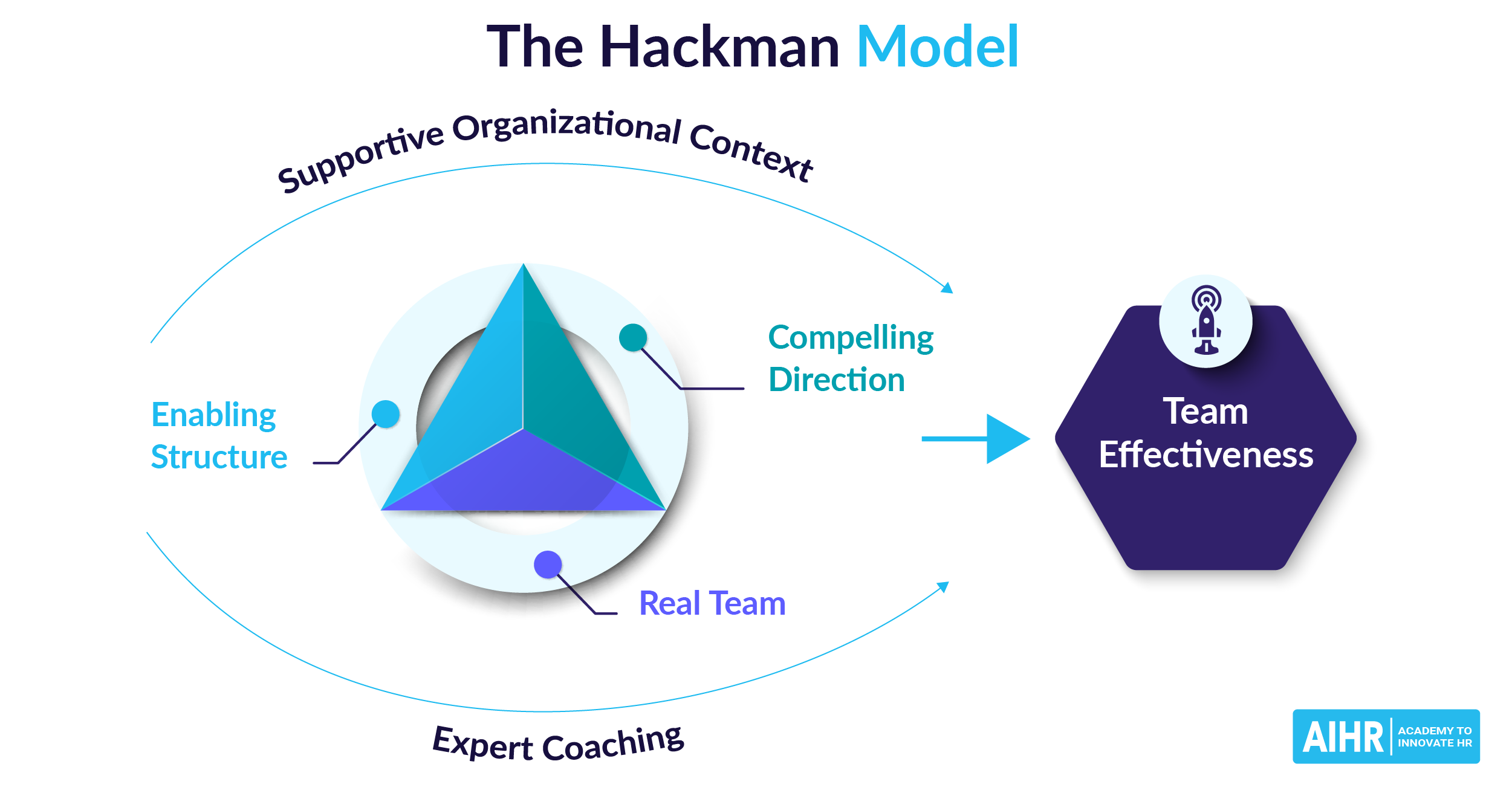Bumping Rights
What are bumping rights?
Bumping rights are contractual provisions that allow employees with greater seniority to assume the roles of less tenured colleagues when positions are downsized, eliminated, or significantly changed. Senior employees can move into these roles if they meet the necessary qualifications.
The displaced employee may be offered another position within the organization or, in some cases, face termination. These rights are commonly outlined in union agreements or company policies, and HR professionals must handle them with attention to legal and contractual obligations.
How do bumping rights work?
To get an understanding of the nature of bumping rights, here is an overview of how they typically work:
- Triggered by layoffs or restructuring: Bumping usually occurs when positions are eliminated due to layoffs, organizational restructuring, or other significant changes.
- Based on seniority: Bumping rights are based on the principle of seniority. Employees with more tenure in the organization are typically granted these rights.
- Prioritization of eligible jobs: Typically, the process prioritizes roles within the same or similar job classifications, such as those with comparable responsibilities and pay grades. In some cases, employees may need to move into lower-level roles with reduced pay, depending on the policies in place.
- Formal agreements: Bumping rights must be part of collective bargaining agreements or any other labor agreements or company policy for them to be legally implemented.
- Notification required: Employees eligible to exercise their rights must be formally informed during layoffs or restructuring. Similarly, displaced employees should be notified and provided with an explanation of their options.
- Skill requirements: Employees must be capable of performing the core duties of the new position they are transitioning into.

Advantages and disadvantages of bumping rights
There are some important pros and cons of bumping rights, including:
Advantages
- Encourages career development: Bumping rights motivate employees to stay with the organization, knowing their tenure offers greater job protection.
- Recognizes loyalty and experience: These rights reward employees for their tenure and experience, acknowledging their contributions to the organization over time.
- Retention of institutional knowledge: By allowing senior employees to stay, organizations retain valuable expertise and historical knowledge, which can be critical for smooth operations and mentoring junior staff.
- Fair and transparent layoff process: Bumping rights create a structured approach to workforce reductions, minimizing perceptions of unfairness or bias.
Disadvantages
- Potential skills mismatch: Senior employees exercising these rights may not have the exact skills or experience required for the new role, leading to performance issues or the need for additional training.
- Risk of losing high-potential employees: Bumping often affects less senior employees, who might be newer but bring fresh ideas, enthusiasm, or specialized skills. Losing them could harm the organization’s long-term growth.
- Impact on pay equity: If a senior employee moves into a lower-paying role but retains their original salary, it can create pay inequities within the team.
- Complex and time-consuming process: Administering bumping rights involves careful evaluation of qualifications, formal notifications, and compliance with agreements, which can be administratively burdensome.
HR best practices to manage bumping rights
To successfully implement bumping rights for employees, follow these HR best practices:
- Clearly define policies: Ensure bumping rights are outlined in union contracts, employee handbooks, or company guidelines, specifying eligibility, qualifications, and the process for exercising these rights. Make policies easy to understand to avoid confusion or misinterpretation.
- Maintain accurate records: To facilitate a smooth bumping process, keep up-to-date records of employees’ hire dates, tenure, and roles. Regularly update employee skill inventories to quickly assess whether they qualify for positions they may bump into.
- Develop targeted succession plans: Regularly assess the skills and qualifications of tenured employees (e.g., annually) to identify any gaps that may need to be addressed in case of a reorganization or other workforce changes. Design succession plans and evaluate whether these employees can transition into specific positions.
- Ensure fairness: Strictly follow the legal guidelines outlined in employment contracts to ensure compliance, particularly for union bumping rights. Work closely with union representatives before final decisions to ensure rights have been fairly executed.
- Track and evaluate impact: Closely monitor the effects bumping rights have had on teams, departments, and individual employees. Reviewing key metrics such as performance evaluations, employee engagement, and job satisfaction quarterly and annually can provide valuable insights.
- Provide training and support: Before senior employees move into their new roles, offer training and support to make the transition easier. Displaced employees who change or lose their jobs may require coaching or counseling.
- Support managers: Team leaders and department heads may need additional training on managing the disruption caused by bumping, such as effectively communicating and supporting all their team members during and after the bumping process.
HR tip
Although it is not a legal requirement, it is highly recommended to develop a plan for employees not covered under union bumping rights or other employment agreements. Some options to consider include reassignment, outplacement assistance, severance pay, or guidance on accessing unemployment benefits.
FAQ
Bumping rights are the contractual rights of employees with greater seniority to replace employees with less tenure when their jobs are downsized or eliminated. These rights allow senior employees to maintain their jobs by moving into the jobs of lower-level employees.
An example of bumping would be a senior employee whose position is eliminated due to layoffs. Instead of losing their job, they “bump” a less senior employee out of a role for which the senior employee is qualified. For instance, if a manager’s role is cut, they might take over a lower-level supervisor position, displacing the current supervisor with less seniority.
Yes, bumping rights are legal when included in collective bargaining agreements and company policies. The terms must be fairly applied and not based on discriminatory practices.









